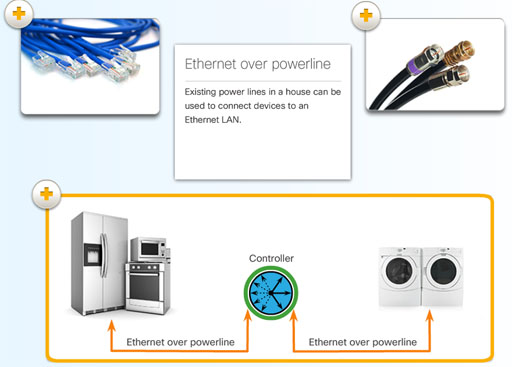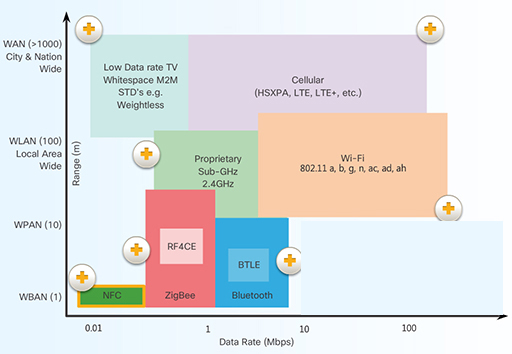3.1.7 Network connectivity
The bottom layer of the TCP/IP model is network access. Network access covers the protocols that devices must use when transferring data across the network. At the network access layer, devices can be connected to the network in one of two ways: wired and wireless.
The most commonly implemented wired protocol is the Ethernet protocol. Ethernet uses a suite of protocols that allow network devices to communicate over a wired LAN connection. An Ethernet LAN can connect devices using many different types of wiring media (Table 2 and Figure 5)
| Category 5 cable (twisted pair) | Coaxial (coax) cable | Ethernet over powerline |
| Category 5 is the most common wiring used in a LAN. The cable is made up of 4 pairs of wires that are twisted to reduce electrical interference. | Coaxial cable has an inner wire surrounded by a tubular insulating layer, that is then surrounded by a tubular conducting shield. Most coax cables also have an external insulating sheath or jacket. | Existing power lines in a house can be used to connect devices to an Ethernet LAN. |
There are a number of wireless network protocols available today. The characteristics of these protocols vary greatly. Figure 6 provides a few common wireless protocols and shows a visual representation of where these protocols fit in the classification spectrum. Table 3 provides more information about each of the protocols. Notice that a protocol can span multiple classifications.
| Weightless | Cellular | Proprietary | Wi-Fi | NFC | ZigBee | Bluetooth |
| Uses the unused portions of the spectrum band in and around TV transmissions. It is a low frequency band which enables excellent propagation without needing large antennas in devices. It has relatively low output power. | The technology behind cell phones is widespread and readily available. Cellular networks are proven, reliable, and provide coverage over vast areas. Some IoT designs are already using consumer cell phones for their connectivity. | This is a communications protocol owned by a single organisation or individual. | This is the name of a popular wireless networking technology that uses radio waves to provide wireless high-speed Internet and network connections. | Near Field Communications is a set of standards for establishing radio communications between devices by touching them together or bringing them into proximity, usually no more than a few inches. | This is a specification for a suite of high-level communication protocols used to create personal area networks built from small, low-power digital radios. | Bluetooth Low Energy (BTLE) is being adopted by the health care industry for portable medical and lifestyle devices. |
In addition to these protocols, there are other network access layer protocols that are available in both wired and wireless form.


